The Adviser
June 2013
- Intern Spotlight: Emily Kaltman
- Major Spotlight: Advertising
- Llano Estacado Photography of West Texas Exhibit
- Professor Spotlight: Kelly Kaufhold, Ph.D.
- Get to Know Your Adviser Q & A: Kathy Lindsey, Advertising
Intern Spotlight: Emily Kaltman
by Stephanie Derkowski, photo by David Vaughn
Internships can vary in a multitude of different industries. From news stations to
agencies, a student in the College of Media & Communication has the opportunity to
experience many different environments within the communications industry.
Emily Kaltman, senior public relations major from Austin, Texas, obtained a marketing internship at the Buddy Holly Center, a non-profit municipal museum for the city of Lubbock. The center is a museum that
honors the famous music artist Buddy Holly, a Lubbock native, as well as provides
music and art events free of cost to the community.
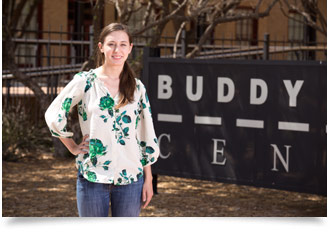
Emily Kaltman at Buddy Holly Center
Kaltman said as a marketing intern for the Buddy Holly Center, she has many tasks
varying day-to-day, including writing press releases, creating invitations and brochures,
and working at events. Kaltman said her favorite tasks as an intern are helping plan
and prepare for events.
“Setting up for an event and watching it all come together, even if I just had a
minor role in it,” Kaltman said, “it still gives me satisfaction and makes me feel
good because I helped contribute.”
Kaltman said she believes this internship will benefit her in many ways that she
will discover more so in her future endeavors. She said working in an office environment
has helped her gain experience that she can use in her future jobs.
Kaltman said some advice for students looking for an internship is to constantly
be checking to see what new internship openings arise and to always make sure to know when deadlines are to apply. For students who
have an internship, Kaltman relayed some advice she received during her time at the
Buddy Holly Center. “Go above and beyond, don't just limit yourself to just the bare
minimum,” Kaltman said, “think of the next step that can be done.”
Major Spotlight: Advertising
by Stephanie Derkowski, photo by David Vaughn
In advertising, a person utilizes both sides of their brain. There is the creative side of advertising, which consists of writing copy and designing the overall look of an advertisement. The other side of advertising is the research and analytical aspect. A person does not create an advertisement just because the piece looks appealing, but because there is research and analysis to back up why it looks that way, and why it says that message.
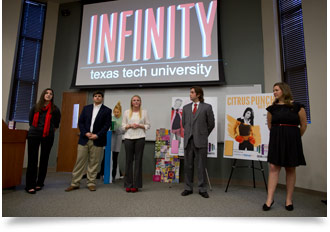
Infinity Advertising Team
Shannon Bichard, Ph.D., advertising department chairperson, said this is the reason she loves advertising.
“It's like this lovely marriage of strategic thinking and creativity.”
Bichard said the best way to define the advertising program at Texas Tech are the
six “C” words: connecting, comparing, critiquing, creating, collaborating and communicating.
Students learn and gain these skills through the program, and Bichard said she believes
this is what sets the advertising program at Texas Tech apart from the rest.
“There are other degree programs at other schools that have a very specific track
that's creative, or a different track that you can almost get your degree in the media
part or the creative copywriting part,” Bichard said, “Our degree program is very
holistic and integrated.”
The best ways to learn all of the different aspects of advertising is to gain hands-on
experience, which Bichard said, the students are given many opportunities for. She
said almost every advertising class has group projects, including the Advertising
Campaigns class where students work for a semester to create a campaign for a real-world
client.
Bichard said other opportunities to gain hands-on experience in advertising is by
joining student organizations including Texas Advertising Federation (TAF), Ad Team, or the Hub. Bichard said also having internship experience is a very beneficial way to gain
experience to prepare students for the work force.
“I think if a student feels that they are a little bit creative, but they also have
an analytic side, weird kind of left-brain and right-brain kind of people,” Bichard
said, “then advertising is a great home for them.”
Llano Estacado Photography of West Texas exhibit
by Morgan Spruiell, photo by David Vaughn
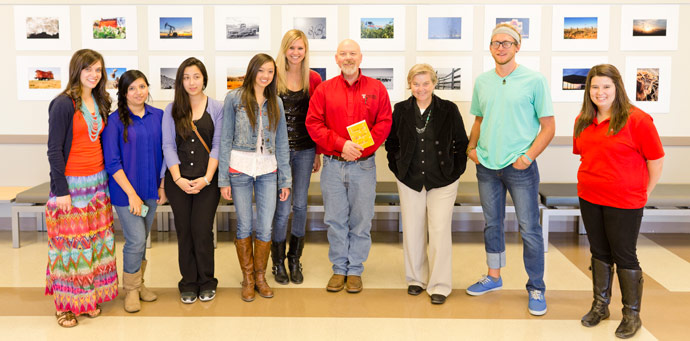
Llano Estacado Photography of West Texas Exhibit
The Llano Estacado Photography of West Texas exhibit opened May 3 on the third floor
of the Media & Communications building. Seven students in Photography 4300 course
showcased their photographs of West Texas. The instructor of the course Kippra Hopper has been teaching in the college since 2007 and said this has been her favorite class
to teach thus far.
"The exhibit is the culmination of their work throughout the semester, so whatever
they shot during the semester they picked out their top three photos to be in the
exhibit," Hopper said.
Students in the class documented sites in Lubbock, Palo Duro Canyon, Post and Lake
Alan Henry, Crosbyton and Blanco Canyon, Old Tascosa, Caprock Canyon, Tulia and Tule
Canyon, and Lake Mackenzie, Borger and Adobe Walls.
The instructor said she urged students to follow back roads, and she printed detailed
maps with all farm-to-market back roads of Texas so that they could travel down unique
paths for their photographic explorations.
At the beginning of the semester, Hopper assigned a reading from the book "Lure of
the Local" by Lucy R. Lippard.
"She's sort of an art critic but she's also a theorist and talks about the importance
of place and how all human beings are in a place, and how that place is a part of
our heritage, our culture, our history, and our current status or condition," Hopper
said.
Any student can participate in upper-level photography courses in the college with
instructor approval and the prerequisite course, PHOT 2310.
"We always say that one thing that makes something newsworthy is locality, well this
is a way that the students could understand that idea of the importance of the local.
So I teach them about essays to go along with their photographic stories, photo cutlines,
how to title their photographs correctly, how to hang them, that's kind of the art
side, but on the news side in journalism, there was an emphasis on the local aspect.
All students created professional websites with their assignment photos, essays and
cutlines."
The students of the course decided to add a video component to the final project,
which will document the new Quanah Parker Trail in the Panhandle-Plains of West Texas.
At significant sites, tall artistic arrows created by a Lubbock artist will mark the
trail through West Texas.
"It was the students' idea to come up with the video on top of the exhibit, which
is really neat when students want to do more because they are excited about the subject,"
Hopper said. "That was gratifying to me as a teacher, and I can't wait to see the
video. It's going to be really interesting." The video will encompass different aspects
of the new trail in Texas that honors Quanah Parker. Parker was the last chief of
the Kwahadi Comanches, the most powerful Indian tribe in the United States. The Llano
Estacado of the Panhandle-Plains was the last land to be settled in the United States.
The "Staked Plains" land was large and empty to most whites, but to the Comanche,
the seas of grassland were home to the largest herds of buffalo, so essential to their
lives. Comanches were rich in horses, the determination of wealth in the tribes of
the Plains of North America.
Students took field trips to the Lubbock Lake Landmark National Historic Site, the
National Ranching Heritage Center, and the American Wind Power Museum. "By going to
those three sites in Lubbock, students could see the documentation of research of
the 12,000 years of human habitation and the history of the Native Americans who passed
through this land at the Landmark, and the early settlement of the pioneers at the
Ranching Heritage Center, to the essential windmills for water that helped new settlers
to survive the hardscrabble and dry land," Hopper said.
Students participating in the group project are: Kirstyn Brokken, Sarah Dang, Chase
Darnell, Jenabeth Gunter, Yadira Martinez, Nicole Molter and Elizabeth Sewell.
"With a smaller class, I've really gotten to know those students and they got to
know me and we really clicked, and they really began working together and collaborating,"
Hopper said. "Every one of my students have said, 'After this class, I will never
see the world the same. I see the world differently.' That's what I want them to do
and to get out of this class."
If you missed the exhibit, check out this link to view the student's photography in the exhibit.
Professor Spotlight: Kelly Kaufhold, Ph.D.
by Morgan Spruiell, photo by David Vaughn
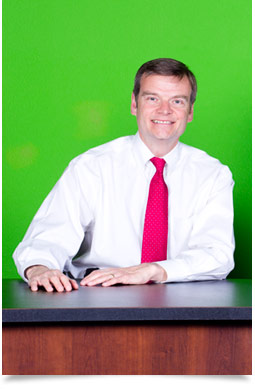
Kelly Kaufhold, Ph.D.
"I swear, the best things come to me by accident! Or should I say, effortless destiny?"
― C. JoyBell C.
This quote perfectly describes the "accidental" situation Kelly Kaufhold, Ph.D., went into the field of journalism and academia.
"I was in pre-law in college, and my sister was working at a television station.
I was in Ohio, and she was in Kansas City, Missouri. She said, 'They are hiring interns
for the summer, do you want to be an intern? Come live with us'. Like as a joke, I
wasn't even studying communications, and I said, 'Yeah, that sounds like fun, let
me go hang out in Kansas City, instead of at my parents'. I was finishing my sophomore
year in college, and so she set me up with an internship at this television station."
The assistant professor said he went to work in the production department for about
a month before being hired. At the end of the summer, Kaufhold returned with experience
and another job lined up at a television station in Dayton, Ohio.
"I just loved it. I changed my major to broadcast journalism ... and went on and
had a nice career in reporting, producing, managing, and doing all kinds of stuff."
Kaufhold has taught a number of different undergraduate and graduate courses in the
college but said the multiplatform class is his favorite to teach. "I always counsel
my students to find the right way to tell the story, because stories lend themselves
to be told in different ways and guess what? I've told all of those stories, in all
of those ways for 20 years."
A fan of newspapers, Kaufhold expressed his love for politics and issues in business
and how he remembers arguing with his father about the editorial content when he was
younger.
"Devil's Advocate" is Kaufhold's talk radio show and "labor of love." He started
in radio in 1979 and radio is not only a personal passion of his but yet another example
of an opportunity open to any interested students in the college to participate in.
"I think there's something fun, simple and elegant about it and I love politics.
What frustrates me about politics, and this is from a long time, old school journalist,
but I always do my best to stay right on the fence of an issue, to be balanced, and
I take it very seriously," Kaufhold said.
He earned his bachelor's degree in broadcast journalism from the University of Dayton,
a master's degree in communication studies from the University of Miami, and finally,
his doctoral degree at the University of Texas.
"Tech is different from all of those and really special in a couple of unique ways.
The biggest one is Tech made a strategic decision about five years ago now to abandon
traditional journalism training and have students spend four years training as a newspaper/print
reporter, a photojournalist, a television news reporter, or a radio journalist. What
we've done is adopted a plan, starting sophomore year, but even as a freshman, with
these practicums or course credits to work in the radio station, TV station, etc.,
to give students hands-on-training in multi-media from freshman year on," Kaufhold
said.
"With students steeped in multi-media, they're going to learn audio, photo, print,
video and web right from the get-go and have all skills reinforced throughout their
time at Tech."
Kaufold has a number of publications and multiple research specialties that include
the role of news consumption in an informed democracy, social media and its role in
disseminating news and information, and the role of age in news consumption and media
economics.
For the love of the state of Texas, Kaufhold decided to come to Texas Tech for research
possibilities, the college's new building, the ability to create courses, like Storytelling
by Smart Phone, and the faculty and department chairpersons, he said.
After years of being a professional journalist and guest lecturing, Kaufhold was
teaching three classes at a small university in Miami where he and his wife were living,
and he said, "That was it, I was hooked. I'm 40 years old, and I finally know what
I want to do for a living."
As a freshman, students have numerous opportunities to get involved with multi-media
outlets like the radio station, The Hub, and MCTV. "Just jump in, if you don't like it, guess what? You can stop after one semester
and try something else, but go ahead and jump in your first year and see what you
like," he said, "because you might have four years having a whole lot of fun working
on one or more media outlets."
Get to Know Your Adviser Q & A: Kathy Lindsey, Advertising
photo by Melissa Wofford
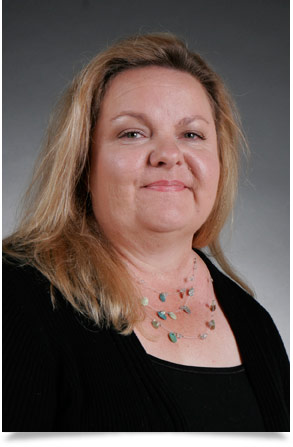
Kathy Lindsey, M.Ed.
Where are you from?
Lubbock, Texas, I've been here my whole life.
Where did you go to college?
Texas Tech University, and both of my degrees are from Texas Tech.
What are your degrees?
I earned a Bachelor of Arts in political science with a minor in history. I thought about law school for about two seconds and then that was that. Then I earned a master's degree in education.
What is your favorite Texas Tech tradition?
I absolutely love the fact that Will Roger's horse's rear-end faces A&M. I would have to say that's my absolute favorite.
What are your hobbies?
Well I like to garden and quilt sometimes. I used to show horses, so of course I still love horses, anything horse-related. Once horses are in your blood you're stuck and it's an expensive habit.
What is your favorite part about advising?
The students, of course. I think, personally, advertising students are the best on-campus. I've advised in the Honors College; I've advised over in the College of Business; but the advertising students are the best.
What advice do you have for incoming students?
Get in the habit of talking to your adviser every semester. I think a lot of people get aggravated with the registration holds we have every semester, but really and truly, it's a blessing. If students can learn to look at it that way, and hopefully down the road they'll see it. Having to talk to a human being every semester about what your plans are for the next semester, we hear things, we know things that a lot of times students aren't even aware of.
topSubscribe

Are you interested in receiving The Adviser? If so, please click subscribe.
Archive
topCollege of Media & Communication
-
Address
Texas Tech University, Box 43082, Lubbock, TX 79409 -
Phone
806.742.6500
